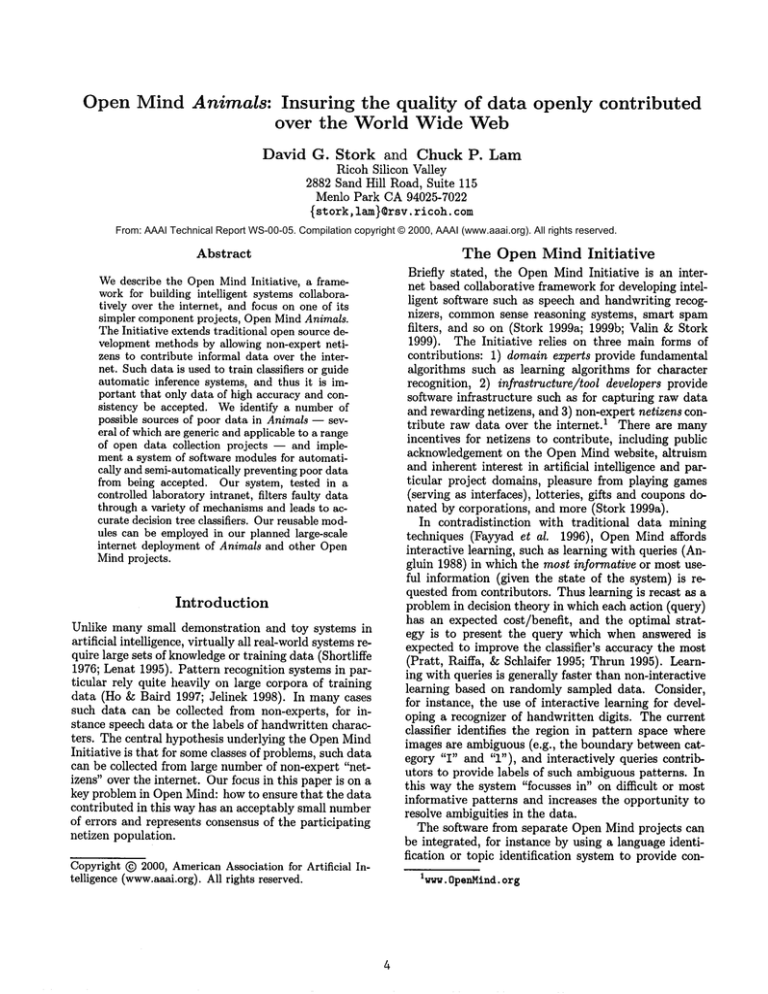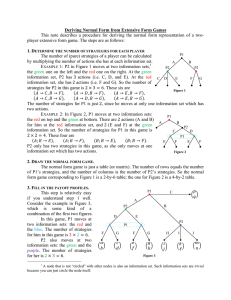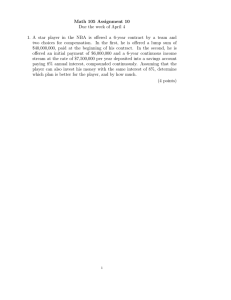
Open Mind Animals:
Insuring the quality of data openly contributed
over the World Wide Web
David
G.
Stork
and Chuck P.
Ricoh Silicon Valley
2882 Sand Hill Road, Suite 115
Menlo Park CA 94025-7022
{stork,lam}¢rsv,
ricoh,com
Lam
From: AAAI Technical Report WS-00-05. Compilation copyright © 2000, AAAI (www.aaai.org). All rights reserved.
Abstract
Wedescribe the Open Mind Initiative, a framework for building intelligent systems collaboratively over the internet, and focus on one of its
simpler componentprojects, Open MindAnimals.
The Initiative extends traditional open source development methods by allowing non-expert netizens to contribute informal data over the internet. Suchdata is used to train classifiers or guide
automatic inference systems, and thus it is important that only data of high accuracy and consistency be accepted. Weidentify a number of
possible sources of poor data in Animals -- several of whichare generic and applicable to a range
of open data collection projects -- and implement a system of software modulesfor automatically and semi-automatically preventing poor data
from being accepted. Our system, tested in a
controlled laboratory intranet, filters faulty data
through a variety of mechanismsand leads to accurate decision tree classifiers. Ourreusable modules can be employedin our planned large-scale
internet deployment of Animals and other Open
Mindprojects.
Introduction
Unlike many small demonstration and toy systems in
artificial intelligence, virtually all real-world systems require large sets of knowledgeor training data (Shortliffe
1976; Lenat 1995). Pattern recognition systems in particular rely quite heavily on large corpora of training
data (Ho & Baird 1997; Jelinek 1998). In many cases
such data can be collected from non-experts, for instance speech data or the labels of handwritten characters. The central hypothesis underlying the Open Mind
Initiative is that for someclasses of problems, such data
can be collected from large number of non-expert "netizens" over the internet. Our focus in this paper is on a
key problem in Open Mind: how to ensure that the data
contributed in this way has an acceptably small number
of errors and represents consensus of the participating
netizen population.
Copyright ~) 2000, AmericanAssociation for Artificial Intelligence (www.aaai.org).All rights reserved.
The Open Mind Initiative
Briefly stated, the Open Mind Initiative is an internet based collaborative frameworkfor developing intelligent software such as speech and handwriting recognizers, commonsense reasoning systems, smart spam
filters,
and so on (Stork 1999a; 1999b; Valin & Stork
1999). The Initiative
relies on three main forms of
contributions: 1) domain experts provide fundamental
algorithms such as learning algorithms for character
recognition, 2) infrastructure/tool developers provide
software infrastructure such as for capturing raw data
and rewarding netizens, and 3) non-expert netizens contribute raw data over the internet. 1 There are many
incentives for netizens to contribute, including public
acknowledgement on the Open Mind website, altruism
and inherent interest in artificial intelligence and particular project domains, pleasure from playing games
(serving as interfaces), lotteries, gifts and couponsdonated by corporations, and more (Stork 1999a).
In contradistinction
with traditional data mining
techniques (Fayyad et al. 1996), Open Mind affords
-interactive learning, such as learning with queries CAn
gluin 1988) in which the most informative or most useful information (given the state of the system) is requested from contributors. Thus learning is recast as a
problem in decision theory in which each action (query)
has an expected cost/benefit,
and the optimal strategy is to present the query which when answered is
expected to improve the classifier’s accuracy the most
(Pratt, Ralffa, & Schlaifer 1995; Thrun 1995). Learning with queries is generally faster than non-interactive
learning based on randomly sampled data. Consider,
for instance, the use of interactive learning for developing a recognizer of handwritten digits. The current
classifier identifies the region in pattern space where
images are ambiguous (e.g., the boundary between category "I" and "1"), and interactively queries contributors to provide labels of such ambiguouspatterns. In
this way the system "focusses in" on difficult or most
informative patterns and increases the opportunity to
resolve ambiguities in the data.
The software from separate Open Mind projects can
be integrated, for instance by using a language identification or topic identification system to provide conlwww.OpenMind.org
straints for handwritten OCR.All the resulting data
and software are then available through an open source
license and experts can propose changes.
The Initiative arose from a deep appreciation of the
following facts and recent trends:
¯ The success and increasing acceptance of open source
development methods and resulting software such as
Linux, emacs, Mozilla and Apache.
¯ The realization that manyproblems in pattern recognition and intelligent systems require very large data
sets that can be provided by non-experts.
¯ The refinement of well developed techniques in pattern recognition, machine learning, grammatical inference, data mining and closely related core disciplines.
¯ The increase in collaboration over the internet, and
the improvementof tools for facilitating such collaboration, both amongexperts and non-experts.
¯ The growth in the participation of non-specialists
(e.g., non-programmers) in group projects over the
internet. Someof these allow participants to donate temporarily unused computer resources, as the
Search for Extraterrestrial Intelligence, 2 Great Internet Mersenne Prime Search, 3 4prime factorization,
and others. 5 In other collaborative projects, netizens
contribute "informal" or non-expert knowledge, as
in the Newhoo! open web directory 6 and MovieLens
~
movie recommendation database.
¯ The massive expansion of the web itself and particularly the growing number of non-specialist netizens
on the web.
Table 1 summarizes some of the differences between
traditional open source and Open Mind.
Current
Open Source
no netizens
expert knowledge
no machine learning
adaptive techniques used
to facilitate
navigation
of contributed data (e.g.,
movie recommendations)
most work is directly on
the final software
hacker/programmer culture (~ 105 contributors
to Linux)
separate
functions
contributed (e.g., Linux
device drivers)
Open Mind
netizens crucial
informal knowledge
machine learning used
machine learning used to
build a single classifier or
AI system (e.g., speech
recognizer)
most work is not on the
final software
netizen/business culture
(~ 108 members)
single function goal (e.g.,
high OCRaccuracy)
Table 1: Comparison of traditional
Open Mind approaches.
open source and
a dynamic pen tablet in a semi-controlled environment.
The segmention information and character labels provided by netizens in this way are used to train multiclassifier based letter and full word recognizers. The
existing data labelling system, written in Java, has been
used successfully by experienced segmenters over an intranet and is being made more robust and user friendly
for deployment on the World Wide Web.
Open Mind projects
There are currently three full Open Mind projects under development. Open Mind speech recognition is
initially addressing the recognition of isolated spoken
Linux commandsand speaker identification
(Valin
Stork 1999). Open Mind common sense builds common sense ontologies and reasoning mechanisms; netizens contribute simple assertions (e.g., "a mother is
older than her children"), ontology information ("all
rabbits are animals"), as well as abstract inferencing
rules. Open Mind handwriting is focussing on recognizing handwritten English words (Schomaker & Stork
2000). Figure 1 shows the web interface for netizen
contributions in this project. Here the netizen’s task
is to segment individual characters in pixel images of
unlabelled handwritten words collected previously with
2setiathome.ssl. berkeley,edu
3~rww.
mersenne,or
E
4www. rsasecurity,com
5dlstributed.net
6www.
dmoz.or
E
7www.movielens,umn. edu
Figure 1: In an Open Mind project for recognizing
handwriting words, netizens segment letters within a
pixel image of a connected handwritten word from an
unlabelled database of scanned or dynamically sampled
handwritten words. Netizens use a mouse to indicate
the beginning and end of each letter, and type the letter’s label, all through a browser interface.
Open Mind Animals
To better understand general problems in infrastructure
and data quality assurance in the Open Mind framework we have implemented a simple "20 questions" AI
game called Animals (Shapiro 1982). During each ses-
sion (game) a decision tree based on animal attributes
is grown in the background. The game proceeds as
follows. The netizen player thinks of a target animal
and the system tries to guess this animal based on the
player’s answers to a sequence of yes/no questions; this
sequence corresponds to a path through a binary decision tree (Fig. 2). The system ventures a guess
the target animal’s identity according to the label at
the leaf node reached this way. If this guess is correct,
then the game is over and the player is encouraged to
play the game again. If instead the guess is incorrect,
then the system asks the player for the identity of the
target animal and to submit a single yes/no question
that distinguishes this target animal from the animal
guessed by the system. The user is awarded a point for
helping the system learn that new animal, as shown in
the sample user session. In the actual implementation,
answers to yes/no questions are entered by clicking on
one of two buttons; animal names are entered by keyboard in an HTMLform. The more the game is played
by players having different knowledge, the larger will
be the resulting tree data structure.
Sample Animals user session
Animals: Welcome to Animals,
an Open
Mind project. Think of an animal and I’ll try
guessing it by asking you a series of yes/no
questions.
Does it have four legs?
Player:
~-~
Animals: Does it have two legs?
Player:
~
Animals: Does it lay eggs?
Player:
~
Animals: Are you thinking
Procedure: Basic Animals
of a human?
Player: [-~
Animals: Well, I guessed wrong. Please help
me learn a new animal. Please give me the
name of the animal you are thinking of.
Player:
~
Animals: Please give me a yes/no question
that will differentiate between a humanand
a gorilla.
Player: II Does it have fur?
Animals:For a gorilla, what is the (yes or no)
answer to your question above?
Player:
Figure 2: The current tree encodes eight leaf nodes.
The player is thinking of the target animal GORILLA,
and answers the questions corresponding to the heavy
path; the system then guesses the animal at the associated leaf node, i.e., HUMAN.
As this is an incorrect
guess, the player is then asked to contribute a new question that distinguishes her target animal from the one
guessed by the system. This new question, here does it
have fur?, replaces the previous leaf node and the decision tree is expanded. Note that one of the leaf nodes
contains synonyms (CHICKENand HEN).
~
Animals: Thanks. I’ll remember that! You
have been awarded an extra point. Would
you like to play again?
The basic Animals procedure is shown below.
1.
2.
3.
4.
Initialize X to be the root node.
If X is a leaf node, then skip to step 6.
Ask the question at X.
If the player answers "yes," then assign the
"left" child node to be the new X; otherwise
assign the "right" child node to be the new
X.
5. Go to step 2.
6. Ask player if she is thinking of the animal
represented at X.
7. If she answers yes, then stop or else restart
the game by going to step 1.
8. Ask player to give a question that distinguishes her target animal from the one
guessed by the system; expand the tree using
this information.
9. Awardpoints to the user. Stop or else restart
the game by going to step 1.
Ensuring
data quality
The Basic Animals procedure above leads to accurate
trees if and only if the data contributed by players is
accurate. In the general Open Mind approach there are
manynetizen contributors, each having different expertise and reliability.
Thus we now consider sources of
data error and corresponding algorithms, implemented
as software modules, for reducing the amount of faulty
data accepted by the system. It should be stressed
that the modules described here seek to prevent faulty
data from being accepted, as is particularly appropriate when growing a hierarchical tree data structure. A
number of traditional techniques for ensuring database
integrity and accuracy can be used after data collection
which can be applied to additional database structures
(Parsaye & Chignell 1993).
Below we list sources of poor data in Animals and
modular algorithmic approaches to reducing their effects on trees. Someof these problems were unanticipated and became apparent only in preliminary deployments and user tests.
invalid animal name A player might misspell an animal, e.g., GORILA.For that reason, every proposed
animal (leaf node) is checked to see if it occurs in
lexicon of animals compiled semi-automatically from
the web. (This "flat" lexicon did not include animal
synonyms or hierarchical category information, see
below.) If the proposed animal cannot be found in
the lexicon, a warning message is displayed and the
system requests the user to retype the animal. If the
second submission also fails in this way, the game is
halted and no data is accepted into the system.
incorrect item Suppose after a series of questions the
system guesses an animal that the player feels does
not correspond to her reply to the one of the questions. For instance, suppose the player answers "yes"
to the question four legs? and the system nevertheless guesses HUMAN.The current player can,
through a simple dialog interface, bring this questionable leaf node to the attention of the domainexpert
-- someone who can independently check the quality of the data. The questionable animal name at
the leaf node, and the list of questions and coded answers leading to it, are sent to the domainexpert (or
independent player), whoserves as final arbiter. In
the meantime, the questionable node is locked and
cannot be modified.
inconsistency/non-uniqueness
A special case of the
previous source of error occurs whena player seeks to
add an animal that occurs at another leaf, i.e., elsewhere in the tree. For example, suppose a player tries
to contribute DOGat the node currently labelled
KANGAROO
in Fig. 2. This submission is inconsistent with the information about DOGpreviously submitted. To filter such inconsistent information, our
moduleautomatically brings to the attention of current netizen the lowest query node antecedent to both
the nodes that would represent DOG.The question in
this node, here hop?, was answered differently by two
players. Our module automatically sends a warning
message to the player seeking to add the conflicting
information. If that player still seeks to submit this
information, such information is accepted, but both
conflicting leaf nodes are locked and a messageis sent
to a domain expert or independent player who acts
as final arbiter.
submission collisions In deployments accessible by
large numbers of netizens (such as on the World Wide
Web), it becomes probable that two players will try
to contribute different animals at a particular tree
node simultaneously. To accommodate such colliding submissions, we have implemented a module that
allows the first netizen to modify the tree node and
locks the node from the second netizen for 30 seconds. During this time a warning notice is displayed
to the second netizen.
Wealso implemented an alternate strategy in which
the system recognizes that the first player has
changed the leaf node between the time the second
player is asked to add a new animal. In this case the
system can trace down the modified tree to find the
appropriate place to add the new animal. Suppose for
example the first player has entered the information
to differentiate cats from dogs and the second player
has entered information to differentiate
cows from
dogs, and the first player’s modifications reached the
system first and has taken effect. Recognizing the
situation when processing the second player’s input,
the system asks the second player the new questions
in the decision tree (e.g., "Please tell me more about
a cow. Does it bark?") until it reaches a leaf node
again. The second player is then given the opportunity to teach the system about cows. If yet another collision occurs, the above process is repeated.
While we expected this alternate strategy would lead
to slightly faster data collection and larger trees, it
proved burdensome and confusing to players.
synonyms Several animals have two or more names
and we would like the tree to represent such information. Suppose the player’s target animal is HEN,
and the system guesses CHICKEN.This is, technically speaking, a correct guess. Nevertheless have
implemented a module that allows the player to add
a synonymto a leaf node, without splitting the leaf
node, as shownin Fig. 2.
subset animal Suppose the player’s target animal is
MANX
and that after answering questions in the tree,
the system guesses CAT. Technically speaking, this
answer is correct. Nevertheless, we wouldlike to capture the information associated with the subcategory
MANXthe netizen has in mind. We have implemented a module that in this case the player can
enter a question that distinguishes her target animal,
MANX,from all other members of the category CAT.
The resulting tree does not represent the fact that a
MANXis a subset of CAT, however.
Software
implementation
Conclusions
and future
directions
Other components of Animals are being built as
reusable codes for future Open Mind projects. Weplan
to expand the user identification component to include
password protection and standardize it such that users
can access all Open Mind projects using just one user
name and password. Wewill also write more lively dialogs for the system in the near future.
There are several additional techniques for increasing
the proportion of high-quality data contributed in open
data aquisition. One method is to require prospective
contributors to read an on-line tutorial, and to pass an
on-line test before he or she can contribute. Not only
would such a tutorial improve the general quality of
the information provided, but the results of the on-line
test would indicate the prospective contributor’s reliability or level of expertise. The results of such tests
could therefore control the level of difficulty or problems posed to each contributor, and could be used to
automatically arbitrate between disagreeing contributors of differing reliabilities.
Westress that we chose Animals for the simplicity
of the core tree growing method so as to allow us to
focus on problems of infrastructure and ensuring data
quality. Our core program and modules for ensuring
data quality can be applied to many other domains,
such as fruit, furniture, automobiles, and so on. Nevertheless, our ultimate challenge is to refine and expand
these techniques to more sophisticated systems such as
handwriting, commonsense reasoning and so forth, and
thus lessons learned from Animals will be invaluable
first steps.
Wefeel that a number of trends, particularly the expansion of the internet and participation of non-experts
in web projects, imply that the general area of open
data aquisition will be increasingly important in the
developmentof artificial intelligence and pattern recognition systems. Indeed, for problems such as very large
commonsense reasoning systems, it is hard to imagine
a cost effective alternative to the OpenMind approach.
These trends highlight the need for further research in
algorithms for filtering and open data acquisition.
Our ultimate goal is to deploy all Open Mind projects,
including Animals, on the world wide web, accessible to
all netizens, regardless of browser type and with minimal burdens of plug-ins and Java. In part for this reason, processing for Animals is done on the server side
using Java servelets. The Animals servelet interacts
with each netizen by dynamically generating HTML
pages. Since the HTTPprotocol is inherently stateless,
the servelet embeds state information within the FORM
tags of each HTMLpage. The HTMLcode generated
is simple, and does not rely on client side Javascript,
Java, MacromediaFlash or other related technologies.
The input to the Animals servelet is just the state information for the user and the player’s action. Given
that input, the Animals servelet will calculate the next
state, updating its database of animals if necessary, and
present to the user a new dynamically generated HTML
page reflecting her new state.
A guiding principle for Open Mindprojects is to make
it easy for netizens to contribute. For this reason, players reply to questions by means of large buttons (yes
or no). Moreover, the current sequence questions and
the player’s answers are updated and left on the screen.
This makes it simpler for netizens to catch errors, as
described in incorrect item and inconsistency/nonuniqueness items in the previous section.
Other server side software, for acknowledgingnetizen
contributions, is written in Java under WindowsNT,
and is quite straightforward. Roughly 10%of our total
code is for the basic Animals procedure, 10%for ensuring data quality, and 50%for I/O and display, and 20%
for parsing commands,setting states, selecting modules and other infrastructure. While this distribution
of code is skewed toward ensuring data quality because
of the simplicity of the basic Animals procedure, we expect that the effort for ensuring data quality will represent a significant portion of the coding work in all such
open data acquisition projects.
Results
Acknowledgements
Weimplemented Animals in a corporate research intranet of 22 users, representing a roughly equal mix
of Netscape Navigator and Internet Explorer browsers.
No effort was made to suggest browser settings such
as fonts or styles and for that reason we developed a
simple text-based interface. While there were no "hostile" players, each of the sources of data fault described
above were present (sometimes by deliberate choice).
In every case, our modules eliminated the faulty data
according to the techniques described above. Manual
inspection of resulting trees (containing over 100 animals) showed no faulty data. Informal interviews afterward revealed that participants found the interface and
the game itself easy and fun.
The authors extend warmthanks to David Bine for donating infrastructure code and to Yann Le Cun for suggesting Animals as a good arena for open data collection.
References
Angluin, D. 1988. Queries and concept learning. Machine Learning 2(4):319-342.
Fayyad, U. M.; Piatetsky-Shapiro, G.; Smyth, P.; and
Uthurusamy, R., eds. 1996. Advances in knowledge discovery and data mining. Cambridge, MA:MIT Press.
Ho, T. K., and Baird, H. S. 1997. Large-scale simulation studies in pattern recognition. IEEE Transactions
8
on Pattern Analysis and Machine Intelligence PAMI19(10):1067-1079.
Jelinek, F. 1998. Statistical Methodsfor Speech Recognition. Cambridge, MA:MIT Press.
Lenat, D. B. 1995. CYC: A large-scale
investment
in knowledge infrastructure.
Communications of the
ACM38(11):33-38.
Parsaye, K., and Chignell, M. 1993. Intelligent
Database Tools and Applications: Hyperinformation
access, data quality, visualization, automatic discovery. NewYork, NY: Wiley.
Pratt, J. W.; Raiffa, H.; and Schlaifer, R. 1995. Introduction to Statistical Decision Theory. Cambridge,
MA: MIT Press.
Schomaker, L., and Stork, D. G. 2000. Open Mind
handwriting recognition, to be submitted.
Shapiro, S. C. 1982. Programming Project 1: Animal Program (20 Questions), "Introduction to Artificial Intelligence," Department of ComputerScience,
State University of NewYork at Buffalo.
Shortliffe, E. H. 1976. Computer-Based Medical Consultations:
MYCIN. NewYork, NY: Elsevier/NorthHolland.
Stork, D. G. 1999a. Documentand character research
in the Open Mind Initiative.
In Proceedings of the
International Conference on Document Analysis and
Recognition (ICDAR99), 1-12.
Stork, D. G. 1999b. The Open Mind Initiative.
IEEE
Intelligent Systems 8~ their applications 14(3):19-20.
Thrun, S. 1995. Exploration in active learning. In Arbib, M., ed., The Handbook of Brain Theory and Neural Networks, 381-384. Cambridge, MA:MIT Press.
Valin, J., and Stork, D. G. 1999. Open Mind speech
recognition. In Proceedings of the Automatic Speech
Recognition and Understanding Workshop (ASRU99).







